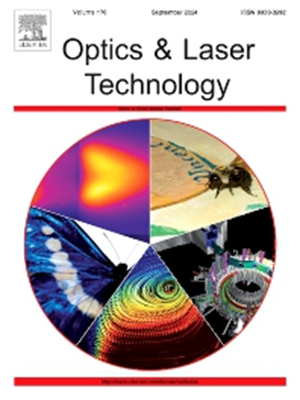Effect of interfacial temperature on the bonding morphology and fracture mechanism of TC4-CFRTP laser bonding joints with polymer interlayer
IF 4.6
2区 物理与天体物理
Q1 OPTICS
引用次数: 0
Abstract
Carbon fiber reinforced thermoplastic composites (CFRTP) and TC4 are widely utilized in aerospace. Incorporating a polymer interlayer during laser bonding of CFRTP/TC4 stacked structures enhances joint performance. However, challenges such as thermal defects and poor bonding at the interface persist. In this paper, the effect of interfacial temperature characteristics on the performance of joints containing polymer layer is systematically analyzed in conjunction with the peak interfacial temperature and its distribution, as well as the polymer melting time. The interfacial temperature characteristics with different powers and their effects on joint mechanical property, bonding morphology, and fracture mechanism, were analyzed through laser joining experiments and temperature field simulations. And the optimal temperature conditions for achieving the high-quality joint were determined. Results indicated that different temperature conditions directly lead to different bonding morphologies and fracture forms. The nonuniform distribution of interface temperature within the laser scanning area causes different fracture forms to occur simultaneously in the joint. Low interfacial peak temperatures and insufficient polymer melting times lead to poor bonding at the interlayer/CFRTP interface, causing failure; Under optimal temperature conditions, the mechanical anchoring structure at the TC4/interlayer interface is unable to withstand shear force, resulting in failure by fracture; When the interfacial peak temperature significantly exceeds the polymer’s decomposition temperature, thermal defects cause stress concentration and lead to failure. The temperature conditions for achieving an optimal joint include a peak temperature of 440 °C, a polymer melting time of 9 s, and as uniform an interface temperature distribution as possible.
求助全文
约1分钟内获得全文
求助全文
来源期刊
CiteScore
8.50
自引率
10.00%
发文量
1060
审稿时长
3.4 months
期刊介绍:
Optics & Laser Technology aims to provide a vehicle for the publication of a broad range of high quality research and review papers in those fields of scientific and engineering research appertaining to the development and application of the technology of optics and lasers. Papers describing original work in these areas are submitted to rigorous refereeing prior to acceptance for publication.
The scope of Optics & Laser Technology encompasses, but is not restricted to, the following areas:
•development in all types of lasers
•developments in optoelectronic devices and photonics
•developments in new photonics and optical concepts
•developments in conventional optics, optical instruments and components
•techniques of optical metrology, including interferometry and optical fibre sensors
•LIDAR and other non-contact optical measurement techniques, including optical methods in heat and fluid flow
•applications of lasers to materials processing, optical NDT display (including holography) and optical communication
•research and development in the field of laser safety including studies of hazards resulting from the applications of lasers (laser safety, hazards of laser fume)
•developments in optical computing and optical information processing
•developments in new optical materials
•developments in new optical characterization methods and techniques
•developments in quantum optics
•developments in light assisted micro and nanofabrication methods and techniques
•developments in nanophotonics and biophotonics
•developments in imaging processing and systems

 求助内容:
求助内容: 应助结果提醒方式:
应助结果提醒方式:


